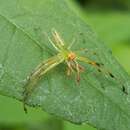en
names in breadcrumbs


Southeastern United States from North Carolina to Texas, down to the New World Tropics.
A small to medium-size jumping spider, 7-8 mm in body length (without legs) for females and 5-6 mm for males. Females are bright green with multiple pairs of small black dots on top of the abdomen. Males are shades of brown to green, with spots or stripes on top of the abdomen. Eyes are located on an orange-red mound on the top of the head.
Common in brushy, deciduous woodlands and also occur in suburban yards. They are often found on the underside of green leaves, which helps them camouflage well. The magnolia name comes from their habit of often being found on magnolia leaves, although they are found on other broadleaf trees as well.
Although they use silk lines during jumping and for building a nest, no web is built for prey capture. Like other members of the jumping spider family, they are diurnal and use their acute vision to pursue prey and then pounce on them at close range. Each eye can move independently and they will change color from green to black, depending on where the spider is looking. When the eyes are black, the spider is looking directly at you. Immature spiders feed heavily on insects such as chironomid midges, while adults consume larger prey, such as syrphid flies.
Individuals overwinter as sub-adults and then reach adulthood in early Spring. In Florida, mating occurs in May and females will lay eggs through early July and die off by August. She attaches the eggs to the underside of leaves with a sheet of silk, and then guards the eggs until hatching.
Lyssomanes viridis, commonly known as the magnolia green jumper, is a species of jumping spider of the genus Lyssomanes, for which it is the type species. The species is native to the United States,[1] being found in much of the Southeastern United States as far north as Pennsylvania and down into parts of Texas.[2][3][4]
L. viridis is the type species of the genus Lyssomanes, which is thought to be one of the earliest-to-evolve genera of jumping spiders, representing a link between the anatomical morphologies and behaviors of more primitive spiders and the family Salticidae.[5]
The magnolia green jumper is small for a jumping spider, with adult females measuring 7-8mm and adult males 5-6mm.[3] Most specimens appear as a pale, partially translucent green (from which they derive a part of their taxonomic and common names) with a small fringe of scales which may appear red, orange, yellow or white on the crown of the head, framing the eyes.[3] L. viridis has longer legs, relative to the body, than most jumping spiders, with a smaller leap size (approximately three to four times their body length).[4] However, L. viridis is similar to most other salticids in having highly complex eyes and well-developed vision that is amongst the most acute of all arthropods, as well as complex visual cognition behaviors; the anterior median eyes have the telephoto quality for which jumping spiders are known, but also share features with the eyes of species that evolved earlier than salticids.[6]
As with many other Salticidae, male L. viridis have brightly-colored and large chelicerae which are used as weapons in contests, and similarly colored forelegs that are waved during visual agonistic displays. The corresponding appendages of females have more muted colors and have significantly lower allometric slopes than those of males. When males encounter each other, they will wave their forelegs and often approach one another until one of them retreats, with a physical fight resulting if neither retreats. During fights, males press their chelicerae and forelegs against each other and push until one tires and retreats.[7][8]
True to its common name, the species often prefers the broad leaves of magnolia trees, particularly in warm, humid forests, but can also be found in dryer climates on oak, maple, pine, and other trees, as well as on bushes lower to the ground.[4] Matings occur in spring months, particularly in May, after which females lay eggs (typically pale green and numbering between 25-70 per clutch[9]) as late as July on the underside of leaves and then guard them until they hatch, with the mothers then dying in August.[10][4] Sub-adults overwinter on trees and then finish developing in the early spring. Both females and males use both visual and vibratory signals in identifying and communicating with one-another, both in challenges and during mating behavior.[11] Pheromones also play a role in identification.[12]
L. viridis subsists primarily on other species inhabiting plants, including mites, aphids, ants, and occasionally other spiders.[4] Because of its relatively short jump distance, compared to other salticids, L. viridis often ambushes its prey, lunging from short distances.[5] Also atypical of salticids, the nests of females are broad and sheetlike and may assist in predation by temporarily immobilizing prey.[5]
Specimens of L. viridis have been commonly observed in most Southeastern states of the U.S., including Texas, Louisiana, Alabama, Mississippi, Tennessee, Arkansas, Florida, Georgia, South Carolina, North Carolina, Virginia, Maryland and the District of Columbia, as well as much of Eastern Mexico and south to Guatemala.[3][4][2] Rarer sightings have been made as far south as Guatemala and as far west as Colorado. The species is particularly populous in Florida (where they are often observed in citrus orchards) and in the tropical and subtropical forests of Mexico.
Mature male feeding on a nematoceran
Mature female specimen, pictured in Greenville County, South Carolina
Lyssomanes viridis, commonly known as the magnolia green jumper, is a species of jumping spider of the genus Lyssomanes, for which it is the type species. The species is native to the United States, being found in much of the Southeastern United States as far north as Pennsylvania and down into parts of Texas.